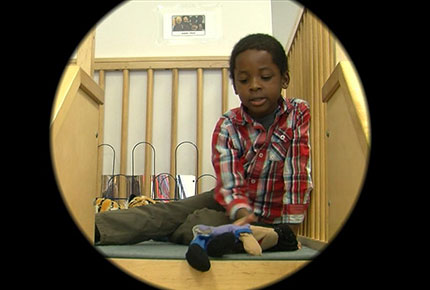Providing a Quiet Place to Be Alone
This video has captions. You can turn them on by clicking the captions icon at the bottom of the video.
Download a printable transcript in English or Spanish.
Patricia Lee, Preschool Teacher, Darcey School: The environment is as much of a science as it is an art. But the part that we really need to provide for our kids is: we need to give them chances to be in a quiet spot.
Providing a Quiet Place to be Alone
Patricia Lee: We all don’t have to be together all the time. We have quiet places in our room. We have places where there are pillows, where the kids can gather and look at a story. The climbing [structure] has tunnel areas where they can go inside and be alone if they need to. We can’t expect them to all be together and all be emotionally in the same place at the same time.
Yotisse Williams, Preschool Teacher, Early Childhood Laboratory School at Housatonic Community College: We have, we call it the “be by myself space.” It’s been called other things different years, but it’s basically a place where children can go if they’re feeling upset, if they’re feeling sad, if they don’t want to be bothered. What I like about it is the fact that the children just go there on their own; it’s like they just go there naturally. We’ve taught them that if we get upset, we get sad, then we can go to a different place until we calm down.
Erin Trudeau, 3rd Grade Teacher, North Windham Elementary School: We also have kind of a Zen Zone or a sensory zone. They know that they can always ask to go to the Zona de zen. Sometimes I’ll ask them, “I can see that you look like you’re feeling a little bit upset. Would you like to take a couple minutes back there?” And so it’s usually just kind of, like, a spot to take a break. There’s different sensory tools and coloring books and maybe some reflection sheets, and I have some little velcro pieces on the wall that students can pull off that say, like, “I’m feeling angry. Here are three things that I can do when I’m feeling angry.”
Emily Grogan, Preschool Teacher, Child and Family Development Resource Center: We call it a cozy area, where they can go and fidget and kind of move. And we have balls that you squeeze, and they kind of like open up, or like the toys or the things that you pull and they stretch. It helps them all get their kind of frustration out or calm their body all at the same time.
Patricia Lee: As adults, we need to recognize that when a child’s behavior is falling apart, and a child’s behavior is dysregulated, it could be us. It could be something we’re doing that’s really causing it. And we need to look at the environment. “What can we change? What can we do to change what’s happening in here, because so-and-so is really having a tough time right now, and maybe it’s something that we can do to help the child.”
© 2022 Center for Early Childhood Education at Eastern Connecticut State University
May be reprinted for educational purposes.



